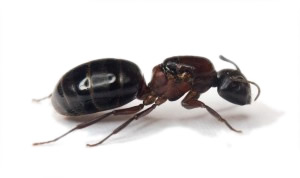Home Pest Guide Carpenter Ant

Description
Size: Between 1/4 inch and 1 inch depending on the actual species.
Carpenter ants are black, dark red or dark brown in overall color with pale or faint grey bands around the abdomen. They cannot sting, but they do have powerful mandibles to pinch. There are various workers in a single colony as they are specialized in function. There are over a thousand species of carpenter ants but black carpenter ant is probably the most common and largest ant in northern states.
Importance
Carpenter ants are considered structural wood pests because they can chew through wood to create a nest and search for food.
Outdoor nesting sites include landscape wood pieces, dead tree branches, stumps, any hollow wood or even telephone poles. They prefer decaying or rotten wood to start the colony. They are most active outdoors April through October, during which time you may see an occasional foraging worker indoors since these ants have a roaming range of up to 100 yards.
Mature outdoor nests contain a few thousand to ten thousand members, and may give rise to satellite nests indoors. Once inside, the nests are started from where structure deficiencies occur. Such deficiencies include water leakages, wet crawl spaces/basements, around bathtubs, toilets, sinks or dishwasher. They can live in a damaged window frame or baseboard, behind dishwashers, showers, or even insulation. Occasionally, they can chew on the sound wood of supporting lumber.
Carpenter ants feed on other insects, both living and dead. Inside, they prefer sweets, including honeydew, syrup, honey, sugar, and jelly. They also feed on fruits and meat.
Control Methods
- Eliminate high moisture conditions that are attractive to carpenter ants.
- Replace any damaged damp wood or lumber.
- Be careful that wood or lumber that is stored in a garage or near the house is kept dry and, if possible, elevated to allow air circulation.
- Repair and caulk all cracks in foundations.
- Replace weather strip or door sweep if necessary, caulk around exterior door/window.
- Seal holes and cracks on the outside of the structure.






